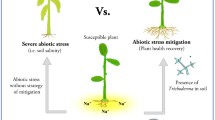Abstract
Mycorrhizal symbiosis can potentially improve water uptake by plants. In a controlled pot culture experiment, soybean plants were inoculated with two species of arbuscular mycorrhizal fungi, Glomus mosseae (Gm) or Glomus etunicatum (Ge), or left non-inoculated (NM) as control in a sterile soil. Four levels of soil moisture (Field capacity, 0.85 FC, 0.7 FC, 0.6 FC) in the presence or absence of the Bradyrhizobium japonicum, were applied to the pots. Relative water content (RWC) of leaf at both plant growth stages (flowering and seed maturation) decreased with the dryness of soil; RWC was higher in all mycorrhizal than non-mycorrhizal plants irrespective of soil moisture level. At the lowest moisture level (0.6 FC) Ge was more efficient than Gm in maintaining high leaf RWC. Leaf water potential (LWP) had the same trend as RWC in flowering stage but it was not significantly influenced by decrease in soil moisture to 0.7 FC during seed maturation stage. Seed and shoot dry weights were affected negatively by drought stress. Mycorrhizal plants, however had significantly higher seed and shoot dry weights than non-mycorrhizal plants at all moisture levels except for seed weight at 0.6 FC. Root mycorrhizal colonization was positively correlated with RWC, LWP, shoot N and K, and seed weight, implying improvement of plant water and nutritional status as a result of colonization. Regardless of moisture treatments, bacterial inoculation caused a significant enhancement in N content and the highest N occurred in rhizobial inoculated plants at 0.85 FC and 0.7 FC. Shoot K was enhanced considerably by both bacterial and fungal inoculations, particularly in plants with dual inoculations where the highest shoot K levels were found. The relatively higher shoot and seed dry weights in plants inoculated with both G. etunicatum and B. japonicum could be ascribed to their higher RWC and LWP, suggesting that drought avoidance is main mechanism of this plant-microbe association in alleviation of water stress in soybean.
Similar content being viewed by others
References
Aliasgharzad, N., Barin, M. & Samadi, A. 2005. Effects of NaCl-induced and mixture salinities on leaf proline and growth of tomato in symbiosis with arbuscular mycorrhizal fungi, pp. 203–207. In: Proc. of the Int. Conf. on Environ. Management, 28–30 October 2005, Hyderabad, India.
Allen, M.F. 1982. Influence of vesicular-arbuscular mycorrhiza on water movement through Buteloua gracilisLag ex Steud. New Phytol. 91: 191–196.
Allen, M.F. & Boosalis, M.G. 1983. Effects of two species of VA mycorrhizal fungi on drought tolerance of winter wheat. New Phytol. 93: 67–76.
Allen, M.F. 1991. The ecology of mycorrhiza. Cambridge University Press, Cambridge.
Auge, R.M., Scheckel, K.A. & Wample, R.L. 1986. Greater leaf conductance of well watered VA mycorrhizal rose plants is not related to phosphorus nutrition. New Phytol. 103: 107–116.
Auge, R.M. 2001. Water relations, drought and vesicular-arbuscular mycorrhizal symbiosis. Mycorrhiza 11: 3–42.
Bennet, J.M., Sinclair, T.R., Muchow, R.C. & Custell, S.R. 1987. Dependence of stomatal conductance on leaf water potential, turgor potential and relative water content in field grown soybean and maize. Crop Sci. 27: 984–990.
Cottenie, A. 1980. Methods of plant analysis, pp. 64–100. In: Soil and Plant Testing. FAO Soils Bulletin 38/2.
Dalpe, Y. 1993. Vesicular-arbuscular mycorrhiza pp. 287–307. In: Carter, M.R. (ed.), Soil sampling and methods of analysis, Lewis Publishers.
Faber, B.A., Zasoski, R.J. & Munns, D.N. 1991. A method for measuring hyphal nutrient and water uptake in mycorrhizal plants. Can. J. Bot. 69: 87–94
Hardie, K. 1985. The effect of removal of extraradical hyphae on water uptake by VAM plants. New Phytol. 101: 677–684
Jafarzadeh, A.A. & Abbasi, G. 2006. Qualitative land suit-ability evaluation for the growth of onion, potato, maize and alfalfa on soils of the Khalat Pushan Research Station. Biologia, Bratislava 61(Supl. 19): S349–S352.
Ludlow, M.M. 1989. Strategies in response to water stress, pp. 269–281. In: Kreeb, H.K., Richter, H. & Hinckley, T.M. (eds), Structural and Functional Responses to Environmental Stresses: Water Shortage. SPB Academic, The Hague.
Mansfield, T.A., Hetherington, A.M. & Atkinson, C.J. 1990. Some current aspects of stomatal physiology. Annu. Rev. Plant Physiol. Plant Molec. Biol. 41: 55–75.
Porcel, R., Barea, J.M. & Ruiz-Lozano, J.M. 2003. Antioxidant activities in mycorrhizal soybean plants under drought stress and their possible relationship to the process of nodule senescence. New Phytol. 157: 135–143
Radin, J.W. 1990. Responses of transpiration and hydraulic conductance to root temperature in nitrogen-and phosphorus-deficient cotton seedlings. Plant Physiol. 92: 855–857.
Ruiz-Lozano, J.M. & Azcon, R. 1995. Hyphal contribution to water uptake in mycorrhizal plants as affected by the fungal species and water status. Physiol. of Plant 95: 472–478.
Ruiz-Lozano, J.M., Collados, C., Barea, J.M. & Azcon, R. 2001b. Arbuscular mycorrhizal symbiosis can alleviate drought-induced nodule senescence in soybean plant. New Phytol. 151: 493–502.
Ruiz-Lozano, J.M. 2003. Arbuscular mycorrhizal symbiosis and alleviation of osmotic stress. New perspectives for molecular studies. Mycorrhiza 13: 309–317.
Safir, G.R., Boyer, J.S. & Gerdemann, J.W. 1972. Nutrient status and mycorrhizal enhancement of water transport in soybean. Plant Physiol. 49: 700–703.
Author information
Authors and Affiliations
Rights and permissions
About this article
Cite this article
Aliasgharzad, N., Neyshabouri, M.R. & Salimi, G. Effects of arbuscular mycorrhizal fungi and Bradyrhizobium japonicum on drought stress of soybean. Biologia 61 (Suppl 19), S324–S328 (2006). https://doi.org/10.2478/s11756-006-0182-x
Issue Date:
DOI: https://doi.org/10.2478/s11756-006-0182-x




